How Hofstede’s Dimensions Shape Education Systems in Various Countries
VerifiedAdded on 2023/06/12
|19
|7682
|80
Essay
AI Summary
This essay provides an analysis of how Hofstede's cultural dimensions affect education in various countries, including Japan, Romania, and France. It begins by introducing the concept of education and learning, then delves into Hofstede's framework, which aims to understand cultural differences across countries. The essay examines key dimensions such as Power Distance Index, Individualism vs. Collectivism, Uncertainty Avoidance, Masculinity-Femininity, and Time Orientation, illustrating how these dimensions influence educational practices and values in different cultural contexts. The analysis includes examples from the selected countries, highlighting the impact of cultural values on teaching methods, curriculum development, and student-teacher relationships. The essay also touches upon the role of cultural relativism and the importance of cooperation in a multicultural world, referencing the communist regime's impact on education in Romania and subsequent reforms. This resource is available on Desklib, a platform offering study tools and solved assignments for students.
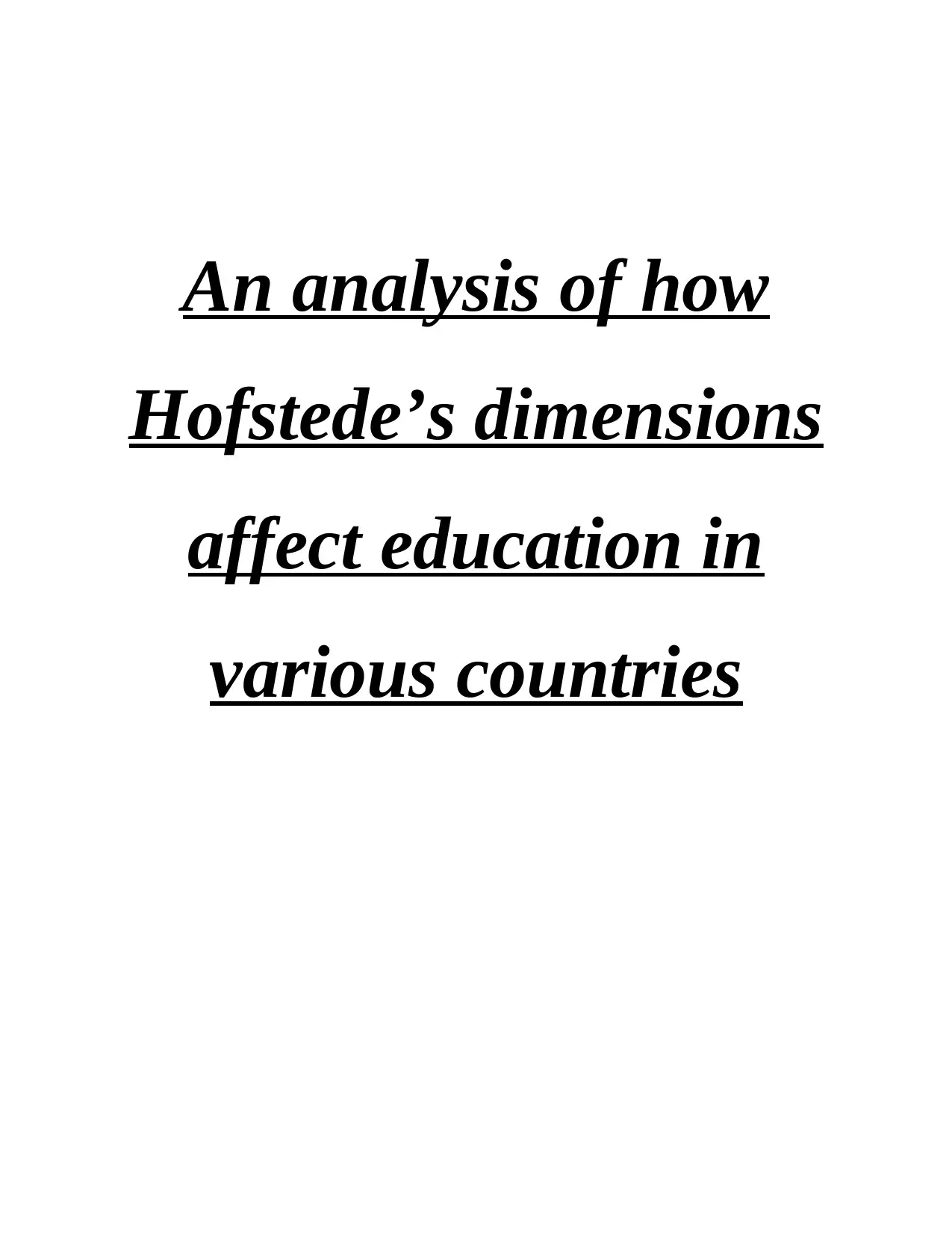
An analysis of how
Hofstede’s dimensions
affect education in
various countries
Hofstede’s dimensions
affect education in
various countries
Paraphrase This Document
Need a fresh take? Get an instant paraphrase of this document with our AI Paraphraser

Table of Contents
INTRDOUCTION...........................................................................................................................1
MAIN BODY...................................................................................................................................1
CONCLUSION................................................................................................................................1
REFERENCES................................................................................................................................2
INTRDOUCTION...........................................................................................................................1
MAIN BODY...................................................................................................................................1
CONCLUSION................................................................................................................................1
REFERENCES................................................................................................................................2
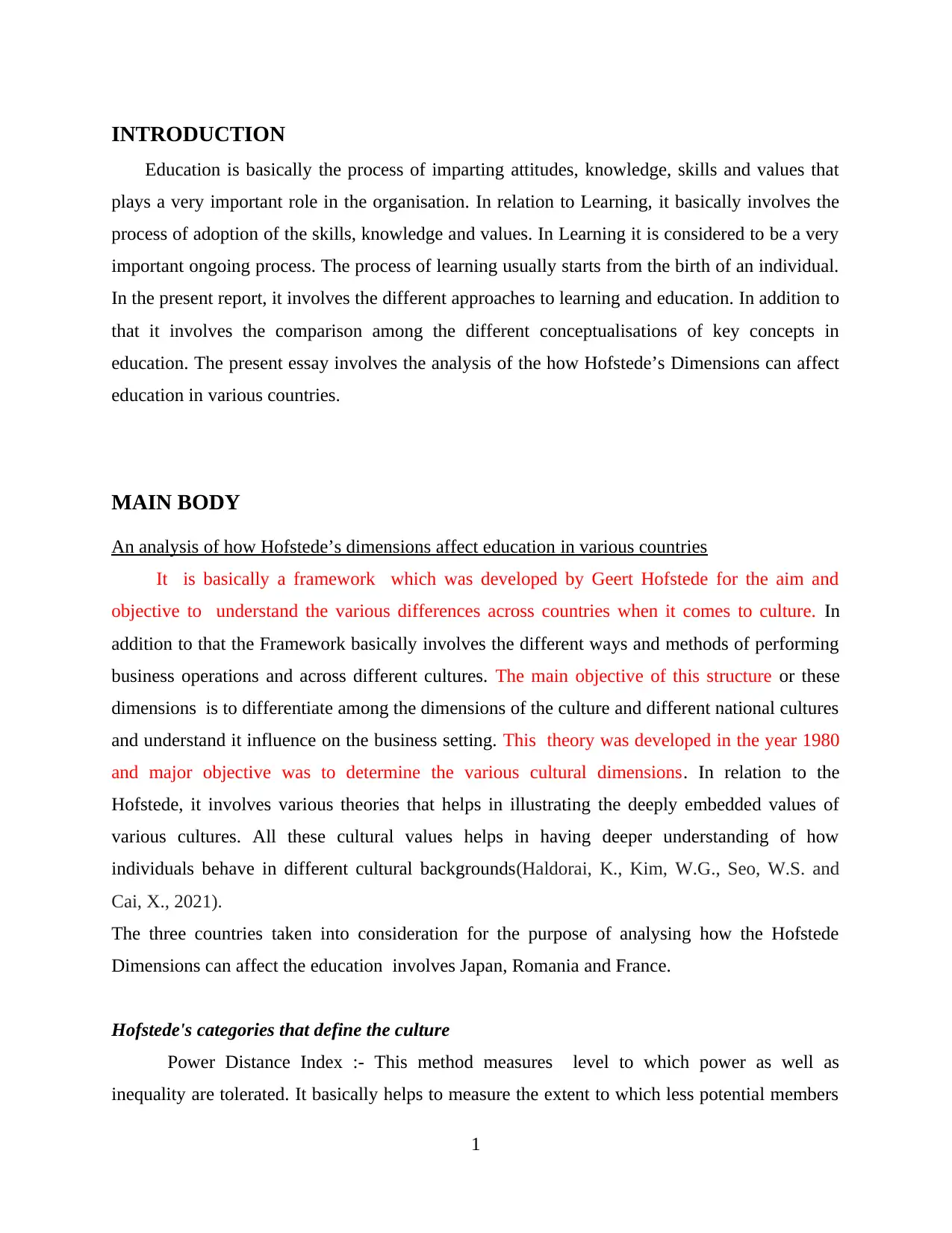
INTRODUCTION
Education is basically the process of imparting attitudes, knowledge, skills and values that
plays a very important role in the organisation. In relation to Learning, it basically involves the
process of adoption of the skills, knowledge and values. In Learning it is considered to be a very
important ongoing process. The process of learning usually starts from the birth of an individual.
In the present report, it involves the different approaches to learning and education. In addition to
that it involves the comparison among the different conceptualisations of key concepts in
education. The present essay involves the analysis of the how Hofstede’s Dimensions can affect
education in various countries.
MAIN BODY
An analysis of how Hofstede’s dimensions affect education in various countries
It is basically a framework which was developed by Geert Hofstede for the aim and
objective to understand the various differences across countries when it comes to culture. In
addition to that the Framework basically involves the different ways and methods of performing
business operations and across different cultures. The main objective of this structure or these
dimensions is to differentiate among the dimensions of the culture and different national cultures
and understand it influence on the business setting. This theory was developed in the year 1980
and major objective was to determine the various cultural dimensions. In relation to the
Hofstede, it involves various theories that helps in illustrating the deeply embedded values of
various cultures. All these cultural values helps in having deeper understanding of how
individuals behave in different cultural backgrounds(Haldorai, K., Kim, W.G., Seo, W.S. and
Cai, X., 2021).
The three countries taken into consideration for the purpose of analysing how the Hofstede
Dimensions can affect the education involves Japan, Romania and France.
Hofstede's categories that define the culture
Power Distance Index :- This method measures level to which power as well as
inequality are tolerated. It basically helps to measure the extent to which less potential members
1
Education is basically the process of imparting attitudes, knowledge, skills and values that
plays a very important role in the organisation. In relation to Learning, it basically involves the
process of adoption of the skills, knowledge and values. In Learning it is considered to be a very
important ongoing process. The process of learning usually starts from the birth of an individual.
In the present report, it involves the different approaches to learning and education. In addition to
that it involves the comparison among the different conceptualisations of key concepts in
education. The present essay involves the analysis of the how Hofstede’s Dimensions can affect
education in various countries.
MAIN BODY
An analysis of how Hofstede’s dimensions affect education in various countries
It is basically a framework which was developed by Geert Hofstede for the aim and
objective to understand the various differences across countries when it comes to culture. In
addition to that the Framework basically involves the different ways and methods of performing
business operations and across different cultures. The main objective of this structure or these
dimensions is to differentiate among the dimensions of the culture and different national cultures
and understand it influence on the business setting. This theory was developed in the year 1980
and major objective was to determine the various cultural dimensions. In relation to the
Hofstede, it involves various theories that helps in illustrating the deeply embedded values of
various cultures. All these cultural values helps in having deeper understanding of how
individuals behave in different cultural backgrounds(Haldorai, K., Kim, W.G., Seo, W.S. and
Cai, X., 2021).
The three countries taken into consideration for the purpose of analysing how the Hofstede
Dimensions can affect the education involves Japan, Romania and France.
Hofstede's categories that define the culture
Power Distance Index :- This method measures level to which power as well as
inequality are tolerated. It basically helps to measure the extent to which less potential members
1
⊘ This is a preview!⊘
Do you want full access?
Subscribe today to unlock all pages.

Trusted by 1+ million students worldwide
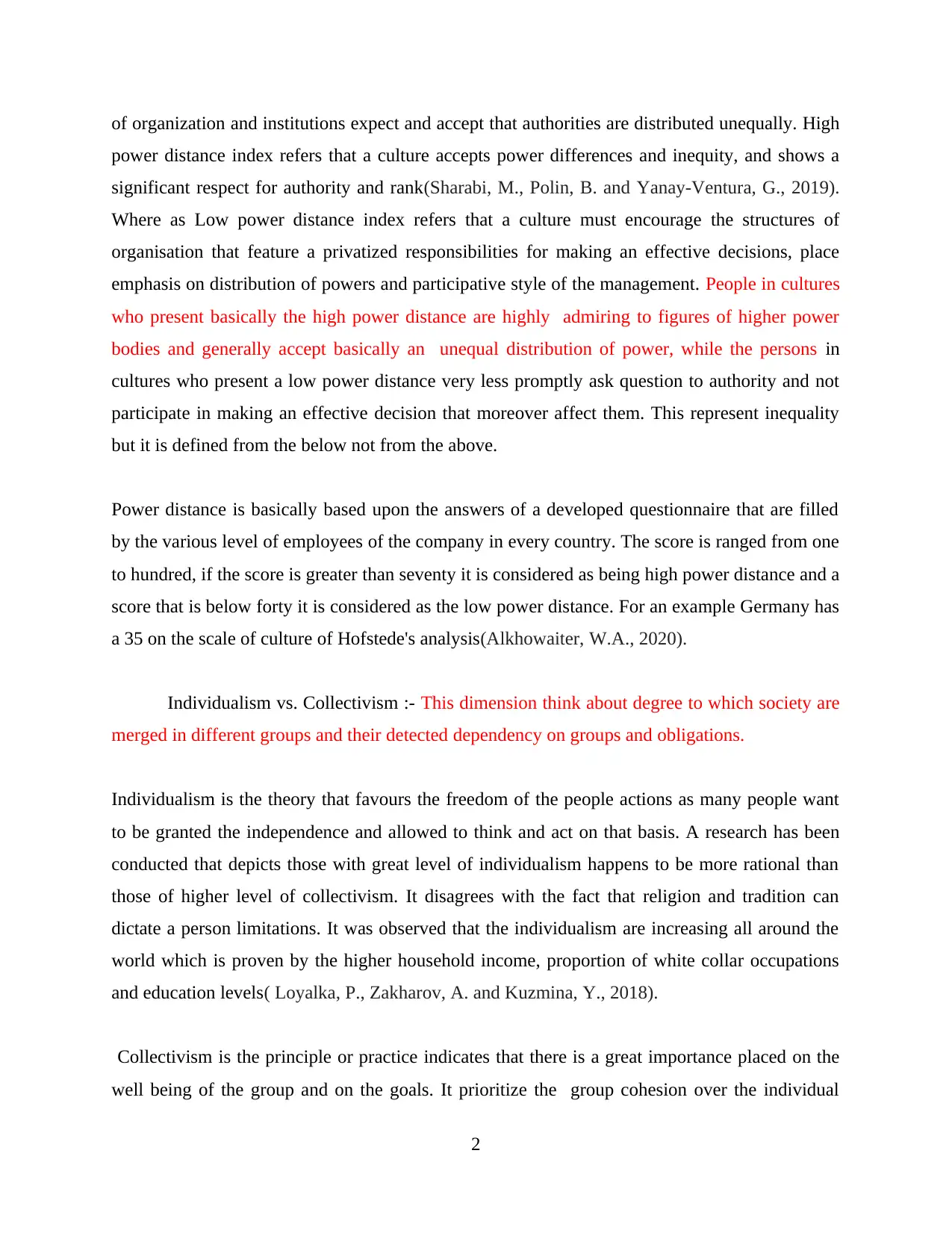
of organization and institutions expect and accept that authorities are distributed unequally. High
power distance index refers that a culture accepts power differences and inequity, and shows a
significant respect for authority and rank(Sharabi, M., Polin, B. and Yanay-Ventura, G., 2019).
Where as Low power distance index refers that a culture must encourage the structures of
organisation that feature a privatized responsibilities for making an effective decisions, place
emphasis on distribution of powers and participative style of the management. People in cultures
who present basically the high power distance are highly admiring to figures of higher power
bodies and generally accept basically an unequal distribution of power, while the persons in
cultures who present a low power distance very less promptly ask question to authority and not
participate in making an effective decision that moreover affect them. This represent inequality
but it is defined from the below not from the above.
Power distance is basically based upon the answers of a developed questionnaire that are filled
by the various level of employees of the company in every country. The score is ranged from one
to hundred, if the score is greater than seventy it is considered as being high power distance and a
score that is below forty it is considered as the low power distance. For an example Germany has
a 35 on the scale of culture of Hofstede's analysis(Alkhowaiter, W.A., 2020).
Individualism vs. Collectivism :- This dimension think about degree to which society are
merged in different groups and their detected dependency on groups and obligations.
Individualism is the theory that favours the freedom of the people actions as many people want
to be granted the independence and allowed to think and act on that basis. A research has been
conducted that depicts those with great level of individualism happens to be more rational than
those of higher level of collectivism. It disagrees with the fact that religion and tradition can
dictate a person limitations. It was observed that the individualism are increasing all around the
world which is proven by the higher household income, proportion of white collar occupations
and education levels( Loyalka, P., Zakharov, A. and Kuzmina, Y., 2018).
Collectivism is the principle or practice indicates that there is a great importance placed on the
well being of the group and on the goals. It prioritize the group cohesion over the individual
2
power distance index refers that a culture accepts power differences and inequity, and shows a
significant respect for authority and rank(Sharabi, M., Polin, B. and Yanay-Ventura, G., 2019).
Where as Low power distance index refers that a culture must encourage the structures of
organisation that feature a privatized responsibilities for making an effective decisions, place
emphasis on distribution of powers and participative style of the management. People in cultures
who present basically the high power distance are highly admiring to figures of higher power
bodies and generally accept basically an unequal distribution of power, while the persons in
cultures who present a low power distance very less promptly ask question to authority and not
participate in making an effective decision that moreover affect them. This represent inequality
but it is defined from the below not from the above.
Power distance is basically based upon the answers of a developed questionnaire that are filled
by the various level of employees of the company in every country. The score is ranged from one
to hundred, if the score is greater than seventy it is considered as being high power distance and a
score that is below forty it is considered as the low power distance. For an example Germany has
a 35 on the scale of culture of Hofstede's analysis(Alkhowaiter, W.A., 2020).
Individualism vs. Collectivism :- This dimension think about degree to which society are
merged in different groups and their detected dependency on groups and obligations.
Individualism is the theory that favours the freedom of the people actions as many people want
to be granted the independence and allowed to think and act on that basis. A research has been
conducted that depicts those with great level of individualism happens to be more rational than
those of higher level of collectivism. It disagrees with the fact that religion and tradition can
dictate a person limitations. It was observed that the individualism are increasing all around the
world which is proven by the higher household income, proportion of white collar occupations
and education levels( Loyalka, P., Zakharov, A. and Kuzmina, Y., 2018).
Collectivism is the principle or practice indicates that there is a great importance placed on the
well being of the group and on the goals. It prioritize the group cohesion over the individual
2
Paraphrase This Document
Need a fresh take? Get an instant paraphrase of this document with our AI Paraphraser
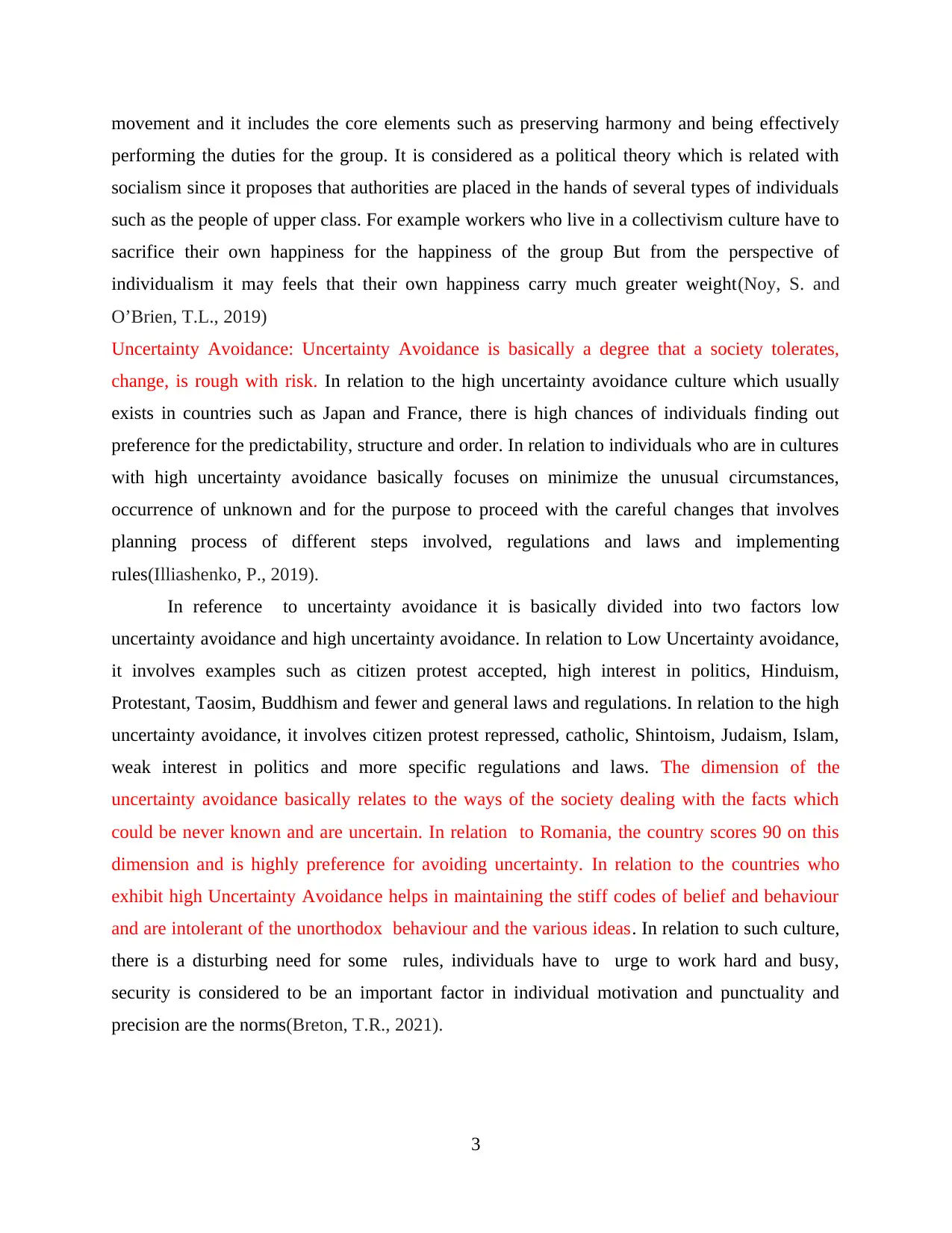
movement and it includes the core elements such as preserving harmony and being effectively
performing the duties for the group. It is considered as a political theory which is related with
socialism since it proposes that authorities are placed in the hands of several types of individuals
such as the people of upper class. For example workers who live in a collectivism culture have to
sacrifice their own happiness for the happiness of the group But from the perspective of
individualism it may feels that their own happiness carry much greater weight(Noy, S. and
O’Brien, T.L., 2019)
Uncertainty Avoidance: Uncertainty Avoidance is basically a degree that a society tolerates,
change, is rough with risk. In relation to the high uncertainty avoidance culture which usually
exists in countries such as Japan and France, there is high chances of individuals finding out
preference for the predictability, structure and order. In relation to individuals who are in cultures
with high uncertainty avoidance basically focuses on minimize the unusual circumstances,
occurrence of unknown and for the purpose to proceed with the careful changes that involves
planning process of different steps involved, regulations and laws and implementing
rules(Illiashenko, P., 2019).
In reference to uncertainty avoidance it is basically divided into two factors low
uncertainty avoidance and high uncertainty avoidance. In relation to Low Uncertainty avoidance,
it involves examples such as citizen protest accepted, high interest in politics, Hinduism,
Protestant, Taosim, Buddhism and fewer and general laws and regulations. In relation to the high
uncertainty avoidance, it involves citizen protest repressed, catholic, Shintoism, Judaism, Islam,
weak interest in politics and more specific regulations and laws. The dimension of the
uncertainty avoidance basically relates to the ways of the society dealing with the facts which
could be never known and are uncertain. In relation to Romania, the country scores 90 on this
dimension and is highly preference for avoiding uncertainty. In relation to the countries who
exhibit high Uncertainty Avoidance helps in maintaining the stiff codes of belief and behaviour
and are intolerant of the unorthodox behaviour and the various ideas. In relation to such culture,
there is a disturbing need for some rules, individuals have to urge to work hard and busy,
security is considered to be an important factor in individual motivation and punctuality and
precision are the norms(Breton, T.R., 2021).
3
performing the duties for the group. It is considered as a political theory which is related with
socialism since it proposes that authorities are placed in the hands of several types of individuals
such as the people of upper class. For example workers who live in a collectivism culture have to
sacrifice their own happiness for the happiness of the group But from the perspective of
individualism it may feels that their own happiness carry much greater weight(Noy, S. and
O’Brien, T.L., 2019)
Uncertainty Avoidance: Uncertainty Avoidance is basically a degree that a society tolerates,
change, is rough with risk. In relation to the high uncertainty avoidance culture which usually
exists in countries such as Japan and France, there is high chances of individuals finding out
preference for the predictability, structure and order. In relation to individuals who are in cultures
with high uncertainty avoidance basically focuses on minimize the unusual circumstances,
occurrence of unknown and for the purpose to proceed with the careful changes that involves
planning process of different steps involved, regulations and laws and implementing
rules(Illiashenko, P., 2019).
In reference to uncertainty avoidance it is basically divided into two factors low
uncertainty avoidance and high uncertainty avoidance. In relation to Low Uncertainty avoidance,
it involves examples such as citizen protest accepted, high interest in politics, Hinduism,
Protestant, Taosim, Buddhism and fewer and general laws and regulations. In relation to the high
uncertainty avoidance, it involves citizen protest repressed, catholic, Shintoism, Judaism, Islam,
weak interest in politics and more specific regulations and laws. The dimension of the
uncertainty avoidance basically relates to the ways of the society dealing with the facts which
could be never known and are uncertain. In relation to Romania, the country scores 90 on this
dimension and is highly preference for avoiding uncertainty. In relation to the countries who
exhibit high Uncertainty Avoidance helps in maintaining the stiff codes of belief and behaviour
and are intolerant of the unorthodox behaviour and the various ideas. In relation to such culture,
there is a disturbing need for some rules, individuals have to urge to work hard and busy,
security is considered to be an important factor in individual motivation and punctuality and
precision are the norms(Breton, T.R., 2021).
3
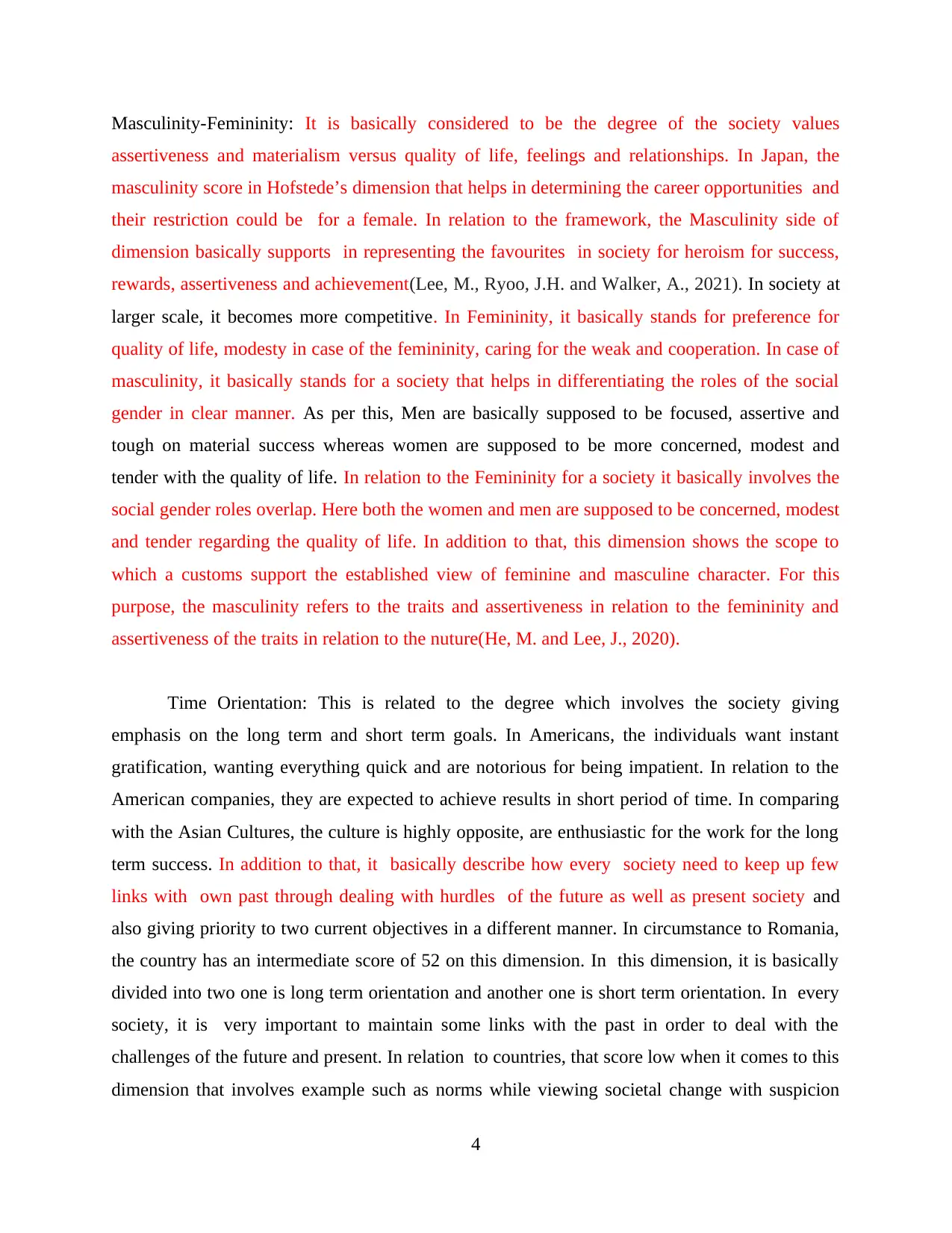
Masculinity-Femininity: It is basically considered to be the degree of the society values
assertiveness and materialism versus quality of life, feelings and relationships. In Japan, the
masculinity score in Hofstede’s dimension that helps in determining the career opportunities and
their restriction could be for a female. In relation to the framework, the Masculinity side of
dimension basically supports in representing the favourites in society for heroism for success,
rewards, assertiveness and achievement(Lee, M., Ryoo, J.H. and Walker, A., 2021). In society at
larger scale, it becomes more competitive. In Femininity, it basically stands for preference for
quality of life, modesty in case of the femininity, caring for the weak and cooperation. In case of
masculinity, it basically stands for a society that helps in differentiating the roles of the social
gender in clear manner. As per this, Men are basically supposed to be focused, assertive and
tough on material success whereas women are supposed to be more concerned, modest and
tender with the quality of life. In relation to the Femininity for a society it basically involves the
social gender roles overlap. Here both the women and men are supposed to be concerned, modest
and tender regarding the quality of life. In addition to that, this dimension shows the scope to
which a customs support the established view of feminine and masculine character. For this
purpose, the masculinity refers to the traits and assertiveness in relation to the femininity and
assertiveness of the traits in relation to the nuture(He, M. and Lee, J., 2020).
Time Orientation: This is related to the degree which involves the society giving
emphasis on the long term and short term goals. In Americans, the individuals want instant
gratification, wanting everything quick and are notorious for being impatient. In relation to the
American companies, they are expected to achieve results in short period of time. In comparing
with the Asian Cultures, the culture is highly opposite, are enthusiastic for the work for the long
term success. In addition to that, it basically describe how every society need to keep up few
links with own past through dealing with hurdles of the future as well as present society and
also giving priority to two current objectives in a different manner. In circumstance to Romania,
the country has an intermediate score of 52 on this dimension. In this dimension, it is basically
divided into two one is long term orientation and another one is short term orientation. In every
society, it is very important to maintain some links with the past in order to deal with the
challenges of the future and present. In relation to countries, that score low when it comes to this
dimension that involves example such as norms while viewing societal change with suspicion
4
assertiveness and materialism versus quality of life, feelings and relationships. In Japan, the
masculinity score in Hofstede’s dimension that helps in determining the career opportunities and
their restriction could be for a female. In relation to the framework, the Masculinity side of
dimension basically supports in representing the favourites in society for heroism for success,
rewards, assertiveness and achievement(Lee, M., Ryoo, J.H. and Walker, A., 2021). In society at
larger scale, it becomes more competitive. In Femininity, it basically stands for preference for
quality of life, modesty in case of the femininity, caring for the weak and cooperation. In case of
masculinity, it basically stands for a society that helps in differentiating the roles of the social
gender in clear manner. As per this, Men are basically supposed to be focused, assertive and
tough on material success whereas women are supposed to be more concerned, modest and
tender with the quality of life. In relation to the Femininity for a society it basically involves the
social gender roles overlap. Here both the women and men are supposed to be concerned, modest
and tender regarding the quality of life. In addition to that, this dimension shows the scope to
which a customs support the established view of feminine and masculine character. For this
purpose, the masculinity refers to the traits and assertiveness in relation to the femininity and
assertiveness of the traits in relation to the nuture(He, M. and Lee, J., 2020).
Time Orientation: This is related to the degree which involves the society giving
emphasis on the long term and short term goals. In Americans, the individuals want instant
gratification, wanting everything quick and are notorious for being impatient. In relation to the
American companies, they are expected to achieve results in short period of time. In comparing
with the Asian Cultures, the culture is highly opposite, are enthusiastic for the work for the long
term success. In addition to that, it basically describe how every society need to keep up few
links with own past through dealing with hurdles of the future as well as present society and
also giving priority to two current objectives in a different manner. In circumstance to Romania,
the country has an intermediate score of 52 on this dimension. In this dimension, it is basically
divided into two one is long term orientation and another one is short term orientation. In every
society, it is very important to maintain some links with the past in order to deal with the
challenges of the future and present. In relation to countries, that score low when it comes to this
dimension that involves example such as norms while viewing societal change with suspicion
4
⊘ This is a preview!⊘
Do you want full access?
Subscribe today to unlock all pages.

Trusted by 1+ million students worldwide
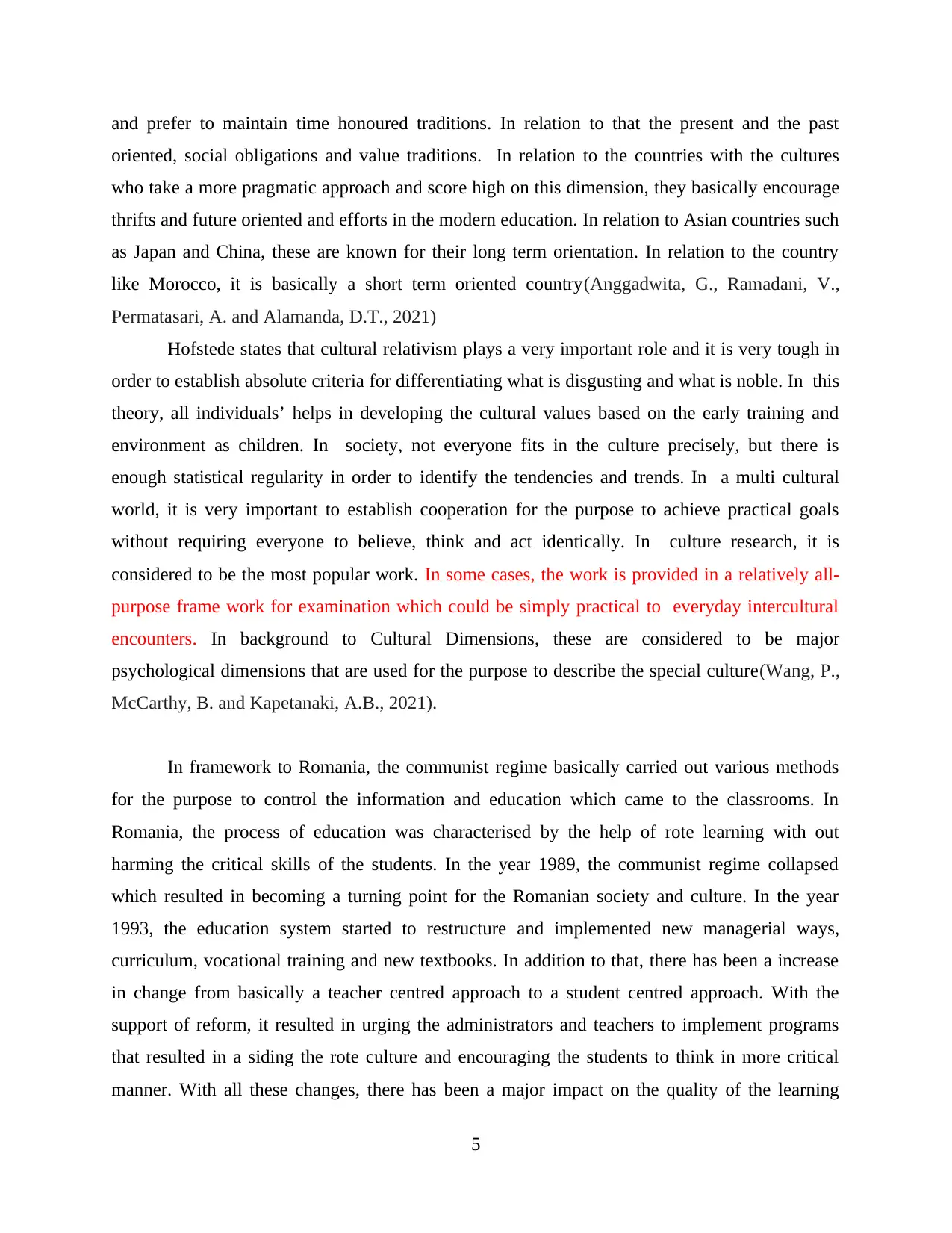
and prefer to maintain time honoured traditions. In relation to that the present and the past
oriented, social obligations and value traditions. In relation to the countries with the cultures
who take a more pragmatic approach and score high on this dimension, they basically encourage
thrifts and future oriented and efforts in the modern education. In relation to Asian countries such
as Japan and China, these are known for their long term orientation. In relation to the country
like Morocco, it is basically a short term oriented country(Anggadwita, G., Ramadani, V.,
Permatasari, A. and Alamanda, D.T., 2021)
Hofstede states that cultural relativism plays a very important role and it is very tough in
order to establish absolute criteria for differentiating what is disgusting and what is noble. In this
theory, all individuals’ helps in developing the cultural values based on the early training and
environment as children. In society, not everyone fits in the culture precisely, but there is
enough statistical regularity in order to identify the tendencies and trends. In a multi cultural
world, it is very important to establish cooperation for the purpose to achieve practical goals
without requiring everyone to believe, think and act identically. In culture research, it is
considered to be the most popular work. In some cases, the work is provided in a relatively all-
purpose frame work for examination which could be simply practical to everyday intercultural
encounters. In background to Cultural Dimensions, these are considered to be major
psychological dimensions that are used for the purpose to describe the special culture(Wang, P.,
McCarthy, B. and Kapetanaki, A.B., 2021).
In framework to Romania, the communist regime basically carried out various methods
for the purpose to control the information and education which came to the classrooms. In
Romania, the process of education was characterised by the help of rote learning with out
harming the critical skills of the students. In the year 1989, the communist regime collapsed
which resulted in becoming a turning point for the Romanian society and culture. In the year
1993, the education system started to restructure and implemented new managerial ways,
curriculum, vocational training and new textbooks. In addition to that, there has been a increase
in change from basically a teacher centred approach to a student centred approach. With the
support of reform, it resulted in urging the administrators and teachers to implement programs
that resulted in a siding the rote culture and encouraging the students to think in more critical
manner. With all these changes, there has been a major impact on the quality of the learning
5
oriented, social obligations and value traditions. In relation to the countries with the cultures
who take a more pragmatic approach and score high on this dimension, they basically encourage
thrifts and future oriented and efforts in the modern education. In relation to Asian countries such
as Japan and China, these are known for their long term orientation. In relation to the country
like Morocco, it is basically a short term oriented country(Anggadwita, G., Ramadani, V.,
Permatasari, A. and Alamanda, D.T., 2021)
Hofstede states that cultural relativism plays a very important role and it is very tough in
order to establish absolute criteria for differentiating what is disgusting and what is noble. In this
theory, all individuals’ helps in developing the cultural values based on the early training and
environment as children. In society, not everyone fits in the culture precisely, but there is
enough statistical regularity in order to identify the tendencies and trends. In a multi cultural
world, it is very important to establish cooperation for the purpose to achieve practical goals
without requiring everyone to believe, think and act identically. In culture research, it is
considered to be the most popular work. In some cases, the work is provided in a relatively all-
purpose frame work for examination which could be simply practical to everyday intercultural
encounters. In background to Cultural Dimensions, these are considered to be major
psychological dimensions that are used for the purpose to describe the special culture(Wang, P.,
McCarthy, B. and Kapetanaki, A.B., 2021).
In framework to Romania, the communist regime basically carried out various methods
for the purpose to control the information and education which came to the classrooms. In
Romania, the process of education was characterised by the help of rote learning with out
harming the critical skills of the students. In the year 1989, the communist regime collapsed
which resulted in becoming a turning point for the Romanian society and culture. In the year
1993, the education system started to restructure and implemented new managerial ways,
curriculum, vocational training and new textbooks. In addition to that, there has been a increase
in change from basically a teacher centred approach to a student centred approach. With the
support of reform, it resulted in urging the administrators and teachers to implement programs
that resulted in a siding the rote culture and encouraging the students to think in more critical
manner. With all these changes, there has been a major impact on the quality of the learning
5
Paraphrase This Document
Need a fresh take? Get an instant paraphrase of this document with our AI Paraphraser
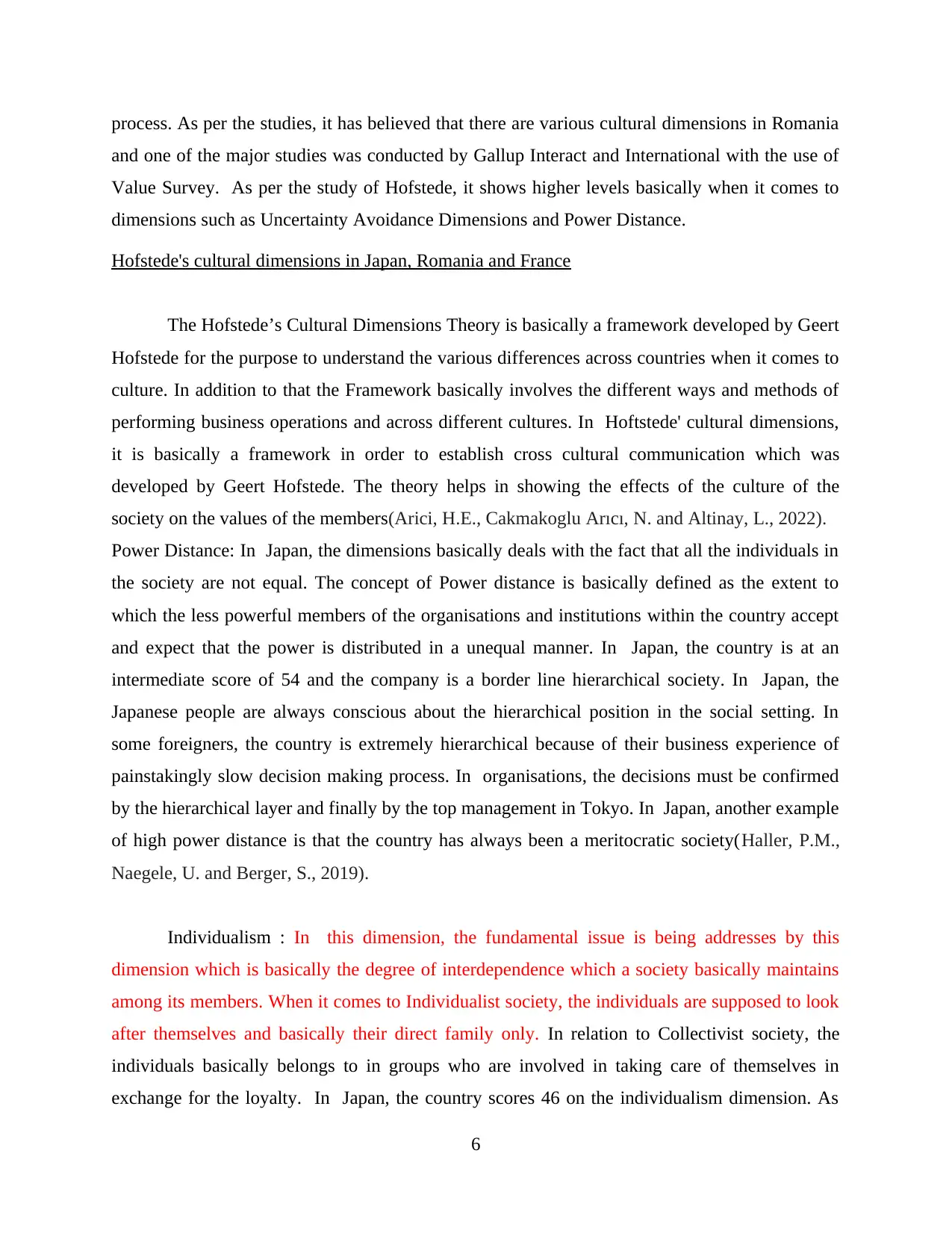
process. As per the studies, it has believed that there are various cultural dimensions in Romania
and one of the major studies was conducted by Gallup Interact and International with the use of
Value Survey. As per the study of Hofstede, it shows higher levels basically when it comes to
dimensions such as Uncertainty Avoidance Dimensions and Power Distance.
Hofstede's cultural dimensions in Japan, Romania and France
The Hofstede’s Cultural Dimensions Theory is basically a framework developed by Geert
Hofstede for the purpose to understand the various differences across countries when it comes to
culture. In addition to that the Framework basically involves the different ways and methods of
performing business operations and across different cultures. In Hoftstede' cultural dimensions,
it is basically a framework in order to establish cross cultural communication which was
developed by Geert Hofstede. The theory helps in showing the effects of the culture of the
society on the values of the members(Arici, H.E., Cakmakoglu Arıcı, N. and Altinay, L., 2022).
Power Distance: In Japan, the dimensions basically deals with the fact that all the individuals in
the society are not equal. The concept of Power distance is basically defined as the extent to
which the less powerful members of the organisations and institutions within the country accept
and expect that the power is distributed in a unequal manner. In Japan, the country is at an
intermediate score of 54 and the company is a border line hierarchical society. In Japan, the
Japanese people are always conscious about the hierarchical position in the social setting. In
some foreigners, the country is extremely hierarchical because of their business experience of
painstakingly slow decision making process. In organisations, the decisions must be confirmed
by the hierarchical layer and finally by the top management in Tokyo. In Japan, another example
of high power distance is that the country has always been a meritocratic society(Haller, P.M.,
Naegele, U. and Berger, S., 2019).
Individualism : In this dimension, the fundamental issue is being addresses by this
dimension which is basically the degree of interdependence which a society basically maintains
among its members. When it comes to Individualist society, the individuals are supposed to look
after themselves and basically their direct family only. In relation to Collectivist society, the
individuals basically belongs to in groups who are involved in taking care of themselves in
exchange for the loyalty. In Japan, the country scores 46 on the individualism dimension. As
6
and one of the major studies was conducted by Gallup Interact and International with the use of
Value Survey. As per the study of Hofstede, it shows higher levels basically when it comes to
dimensions such as Uncertainty Avoidance Dimensions and Power Distance.
Hofstede's cultural dimensions in Japan, Romania and France
The Hofstede’s Cultural Dimensions Theory is basically a framework developed by Geert
Hofstede for the purpose to understand the various differences across countries when it comes to
culture. In addition to that the Framework basically involves the different ways and methods of
performing business operations and across different cultures. In Hoftstede' cultural dimensions,
it is basically a framework in order to establish cross cultural communication which was
developed by Geert Hofstede. The theory helps in showing the effects of the culture of the
society on the values of the members(Arici, H.E., Cakmakoglu Arıcı, N. and Altinay, L., 2022).
Power Distance: In Japan, the dimensions basically deals with the fact that all the individuals in
the society are not equal. The concept of Power distance is basically defined as the extent to
which the less powerful members of the organisations and institutions within the country accept
and expect that the power is distributed in a unequal manner. In Japan, the country is at an
intermediate score of 54 and the company is a border line hierarchical society. In Japan, the
Japanese people are always conscious about the hierarchical position in the social setting. In
some foreigners, the country is extremely hierarchical because of their business experience of
painstakingly slow decision making process. In organisations, the decisions must be confirmed
by the hierarchical layer and finally by the top management in Tokyo. In Japan, another example
of high power distance is that the country has always been a meritocratic society(Haller, P.M.,
Naegele, U. and Berger, S., 2019).
Individualism : In this dimension, the fundamental issue is being addresses by this
dimension which is basically the degree of interdependence which a society basically maintains
among its members. When it comes to Individualist society, the individuals are supposed to look
after themselves and basically their direct family only. In relation to Collectivist society, the
individuals basically belongs to in groups who are involved in taking care of themselves in
exchange for the loyalty. In Japan, the country scores 46 on the individualism dimension. As
6
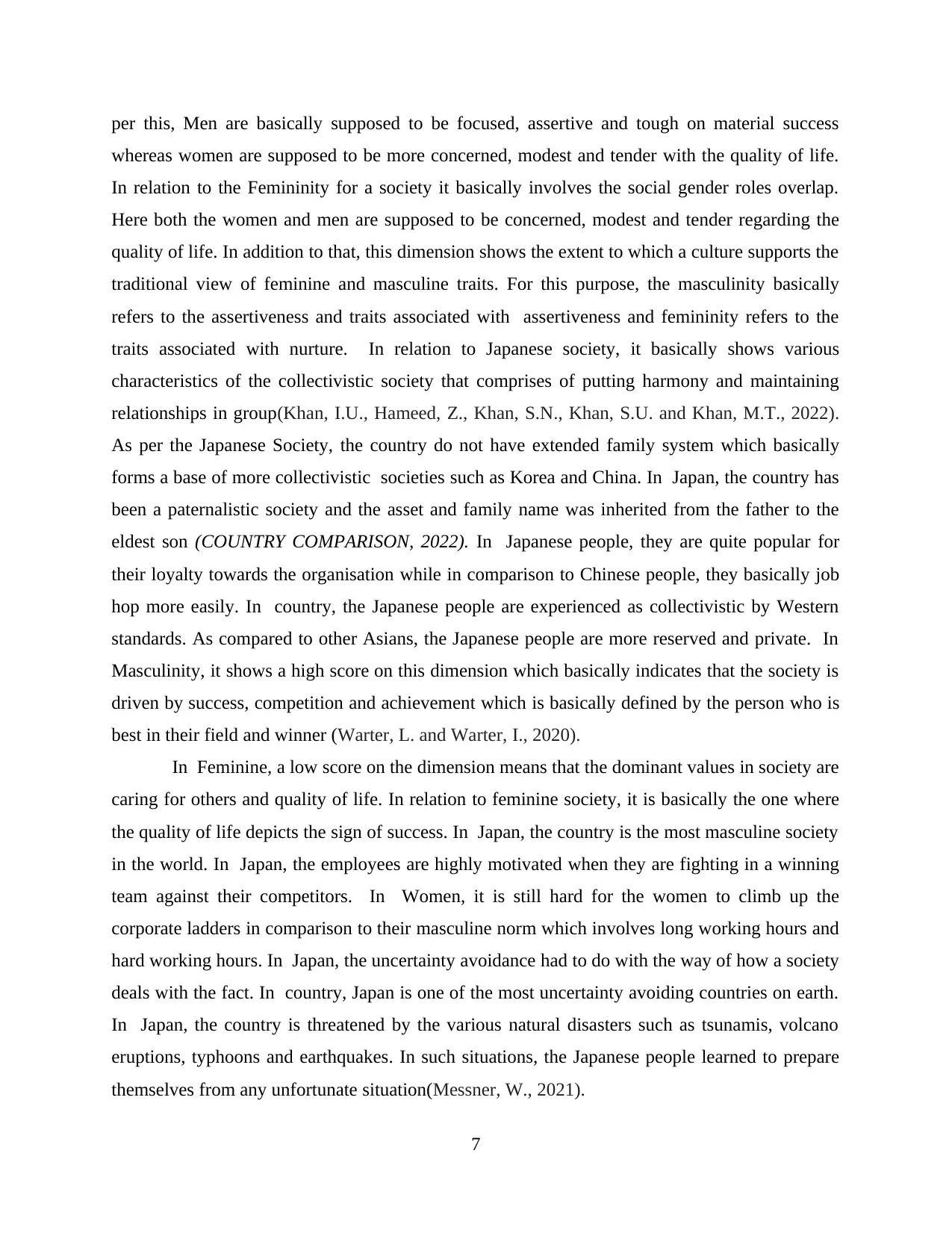
per this, Men are basically supposed to be focused, assertive and tough on material success
whereas women are supposed to be more concerned, modest and tender with the quality of life.
In relation to the Femininity for a society it basically involves the social gender roles overlap.
Here both the women and men are supposed to be concerned, modest and tender regarding the
quality of life. In addition to that, this dimension shows the extent to which a culture supports the
traditional view of feminine and masculine traits. For this purpose, the masculinity basically
refers to the assertiveness and traits associated with assertiveness and femininity refers to the
traits associated with nurture. In relation to Japanese society, it basically shows various
characteristics of the collectivistic society that comprises of putting harmony and maintaining
relationships in group(Khan, I.U., Hameed, Z., Khan, S.N., Khan, S.U. and Khan, M.T., 2022).
As per the Japanese Society, the country do not have extended family system which basically
forms a base of more collectivistic societies such as Korea and China. In Japan, the country has
been a paternalistic society and the asset and family name was inherited from the father to the
eldest son (COUNTRY COMPARISON, 2022). In Japanese people, they are quite popular for
their loyalty towards the organisation while in comparison to Chinese people, they basically job
hop more easily. In country, the Japanese people are experienced as collectivistic by Western
standards. As compared to other Asians, the Japanese people are more reserved and private. In
Masculinity, it shows a high score on this dimension which basically indicates that the society is
driven by success, competition and achievement which is basically defined by the person who is
best in their field and winner (Warter, L. and Warter, I., 2020).
In Feminine, a low score on the dimension means that the dominant values in society are
caring for others and quality of life. In relation to feminine society, it is basically the one where
the quality of life depicts the sign of success. In Japan, the country is the most masculine society
in the world. In Japan, the employees are highly motivated when they are fighting in a winning
team against their competitors. In Women, it is still hard for the women to climb up the
corporate ladders in comparison to their masculine norm which involves long working hours and
hard working hours. In Japan, the uncertainty avoidance had to do with the way of how a society
deals with the fact. In country, Japan is one of the most uncertainty avoiding countries on earth.
In Japan, the country is threatened by the various natural disasters such as tsunamis, volcano
eruptions, typhoons and earthquakes. In such situations, the Japanese people learned to prepare
themselves from any unfortunate situation(Messner, W., 2021).
7
whereas women are supposed to be more concerned, modest and tender with the quality of life.
In relation to the Femininity for a society it basically involves the social gender roles overlap.
Here both the women and men are supposed to be concerned, modest and tender regarding the
quality of life. In addition to that, this dimension shows the extent to which a culture supports the
traditional view of feminine and masculine traits. For this purpose, the masculinity basically
refers to the assertiveness and traits associated with assertiveness and femininity refers to the
traits associated with nurture. In relation to Japanese society, it basically shows various
characteristics of the collectivistic society that comprises of putting harmony and maintaining
relationships in group(Khan, I.U., Hameed, Z., Khan, S.N., Khan, S.U. and Khan, M.T., 2022).
As per the Japanese Society, the country do not have extended family system which basically
forms a base of more collectivistic societies such as Korea and China. In Japan, the country has
been a paternalistic society and the asset and family name was inherited from the father to the
eldest son (COUNTRY COMPARISON, 2022). In Japanese people, they are quite popular for
their loyalty towards the organisation while in comparison to Chinese people, they basically job
hop more easily. In country, the Japanese people are experienced as collectivistic by Western
standards. As compared to other Asians, the Japanese people are more reserved and private. In
Masculinity, it shows a high score on this dimension which basically indicates that the society is
driven by success, competition and achievement which is basically defined by the person who is
best in their field and winner (Warter, L. and Warter, I., 2020).
In Feminine, a low score on the dimension means that the dominant values in society are
caring for others and quality of life. In relation to feminine society, it is basically the one where
the quality of life depicts the sign of success. In Japan, the country is the most masculine society
in the world. In Japan, the employees are highly motivated when they are fighting in a winning
team against their competitors. In Women, it is still hard for the women to climb up the
corporate ladders in comparison to their masculine norm which involves long working hours and
hard working hours. In Japan, the uncertainty avoidance had to do with the way of how a society
deals with the fact. In country, Japan is one of the most uncertainty avoiding countries on earth.
In Japan, the country is threatened by the various natural disasters such as tsunamis, volcano
eruptions, typhoons and earthquakes. In such situations, the Japanese people learned to prepare
themselves from any unfortunate situation(Messner, W., 2021).
7
⊘ This is a preview!⊘
Do you want full access?
Subscribe today to unlock all pages.

Trusted by 1+ million students worldwide
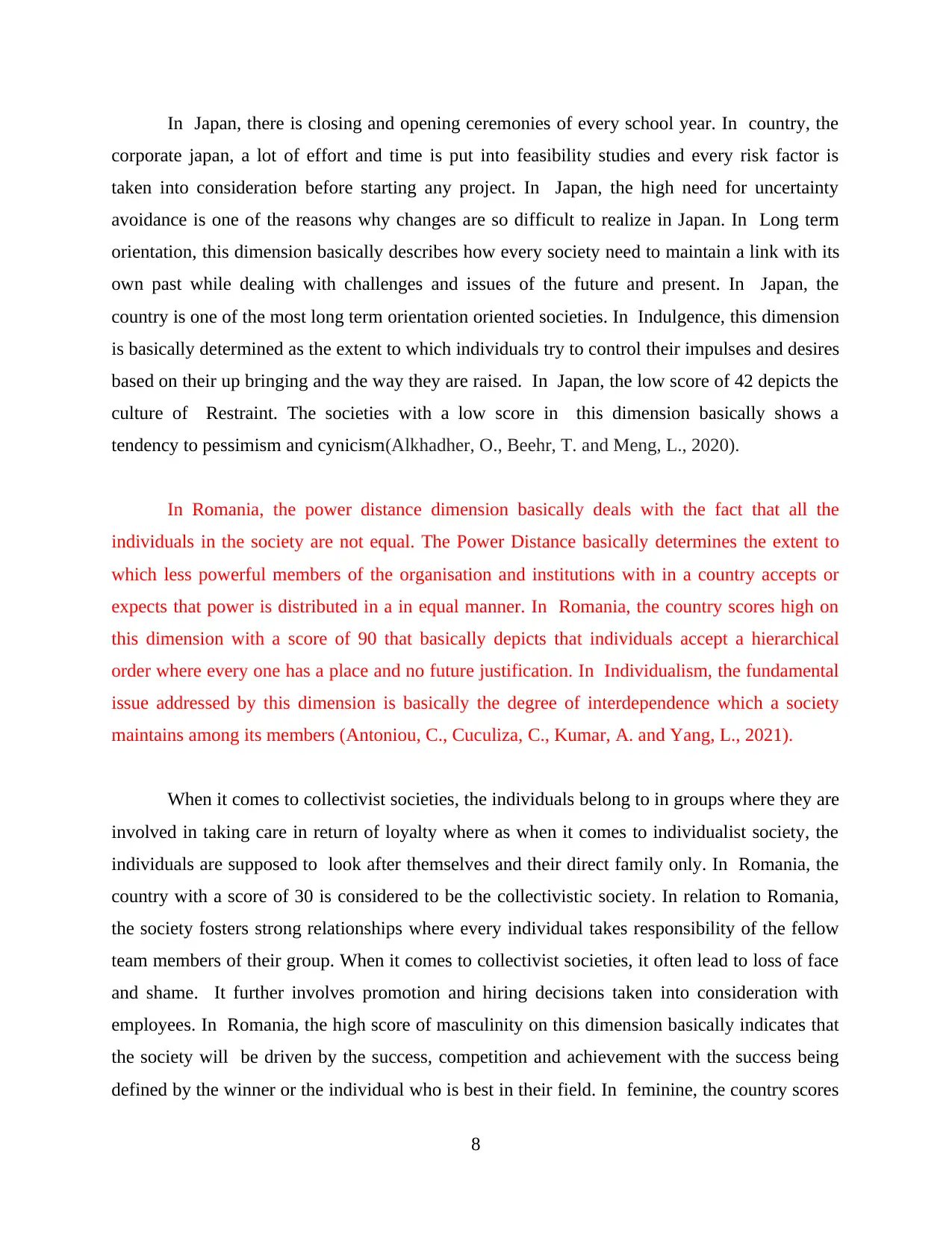
In Japan, there is closing and opening ceremonies of every school year. In country, the
corporate japan, a lot of effort and time is put into feasibility studies and every risk factor is
taken into consideration before starting any project. In Japan, the high need for uncertainty
avoidance is one of the reasons why changes are so difficult to realize in Japan. In Long term
orientation, this dimension basically describes how every society need to maintain a link with its
own past while dealing with challenges and issues of the future and present. In Japan, the
country is one of the most long term orientation oriented societies. In Indulgence, this dimension
is basically determined as the extent to which individuals try to control their impulses and desires
based on their up bringing and the way they are raised. In Japan, the low score of 42 depicts the
culture of Restraint. The societies with a low score in this dimension basically shows a
tendency to pessimism and cynicism(Alkhadher, O., Beehr, T. and Meng, L., 2020).
In Romania, the power distance dimension basically deals with the fact that all the
individuals in the society are not equal. The Power Distance basically determines the extent to
which less powerful members of the organisation and institutions with in a country accepts or
expects that power is distributed in a in equal manner. In Romania, the country scores high on
this dimension with a score of 90 that basically depicts that individuals accept a hierarchical
order where every one has a place and no future justification. In Individualism, the fundamental
issue addressed by this dimension is basically the degree of interdependence which a society
maintains among its members (Antoniou, C., Cuculiza, C., Kumar, A. and Yang, L., 2021).
When it comes to collectivist societies, the individuals belong to in groups where they are
involved in taking care in return of loyalty where as when it comes to individualist society, the
individuals are supposed to look after themselves and their direct family only. In Romania, the
country with a score of 30 is considered to be the collectivistic society. In relation to Romania,
the society fosters strong relationships where every individual takes responsibility of the fellow
team members of their group. When it comes to collectivist societies, it often lead to loss of face
and shame. It further involves promotion and hiring decisions taken into consideration with
employees. In Romania, the high score of masculinity on this dimension basically indicates that
the society will be driven by the success, competition and achievement with the success being
defined by the winner or the individual who is best in their field. In feminine, the country scores
8
corporate japan, a lot of effort and time is put into feasibility studies and every risk factor is
taken into consideration before starting any project. In Japan, the high need for uncertainty
avoidance is one of the reasons why changes are so difficult to realize in Japan. In Long term
orientation, this dimension basically describes how every society need to maintain a link with its
own past while dealing with challenges and issues of the future and present. In Japan, the
country is one of the most long term orientation oriented societies. In Indulgence, this dimension
is basically determined as the extent to which individuals try to control their impulses and desires
based on their up bringing and the way they are raised. In Japan, the low score of 42 depicts the
culture of Restraint. The societies with a low score in this dimension basically shows a
tendency to pessimism and cynicism(Alkhadher, O., Beehr, T. and Meng, L., 2020).
In Romania, the power distance dimension basically deals with the fact that all the
individuals in the society are not equal. The Power Distance basically determines the extent to
which less powerful members of the organisation and institutions with in a country accepts or
expects that power is distributed in a in equal manner. In Romania, the country scores high on
this dimension with a score of 90 that basically depicts that individuals accept a hierarchical
order where every one has a place and no future justification. In Individualism, the fundamental
issue addressed by this dimension is basically the degree of interdependence which a society
maintains among its members (Antoniou, C., Cuculiza, C., Kumar, A. and Yang, L., 2021).
When it comes to collectivist societies, the individuals belong to in groups where they are
involved in taking care in return of loyalty where as when it comes to individualist society, the
individuals are supposed to look after themselves and their direct family only. In Romania, the
country with a score of 30 is considered to be the collectivistic society. In relation to Romania,
the society fosters strong relationships where every individual takes responsibility of the fellow
team members of their group. When it comes to collectivist societies, it often lead to loss of face
and shame. It further involves promotion and hiring decisions taken into consideration with
employees. In Romania, the high score of masculinity on this dimension basically indicates that
the society will be driven by the success, competition and achievement with the success being
defined by the winner or the individual who is best in their field. In feminine, the country scores
8
Paraphrase This Document
Need a fresh take? Get an instant paraphrase of this document with our AI Paraphraser
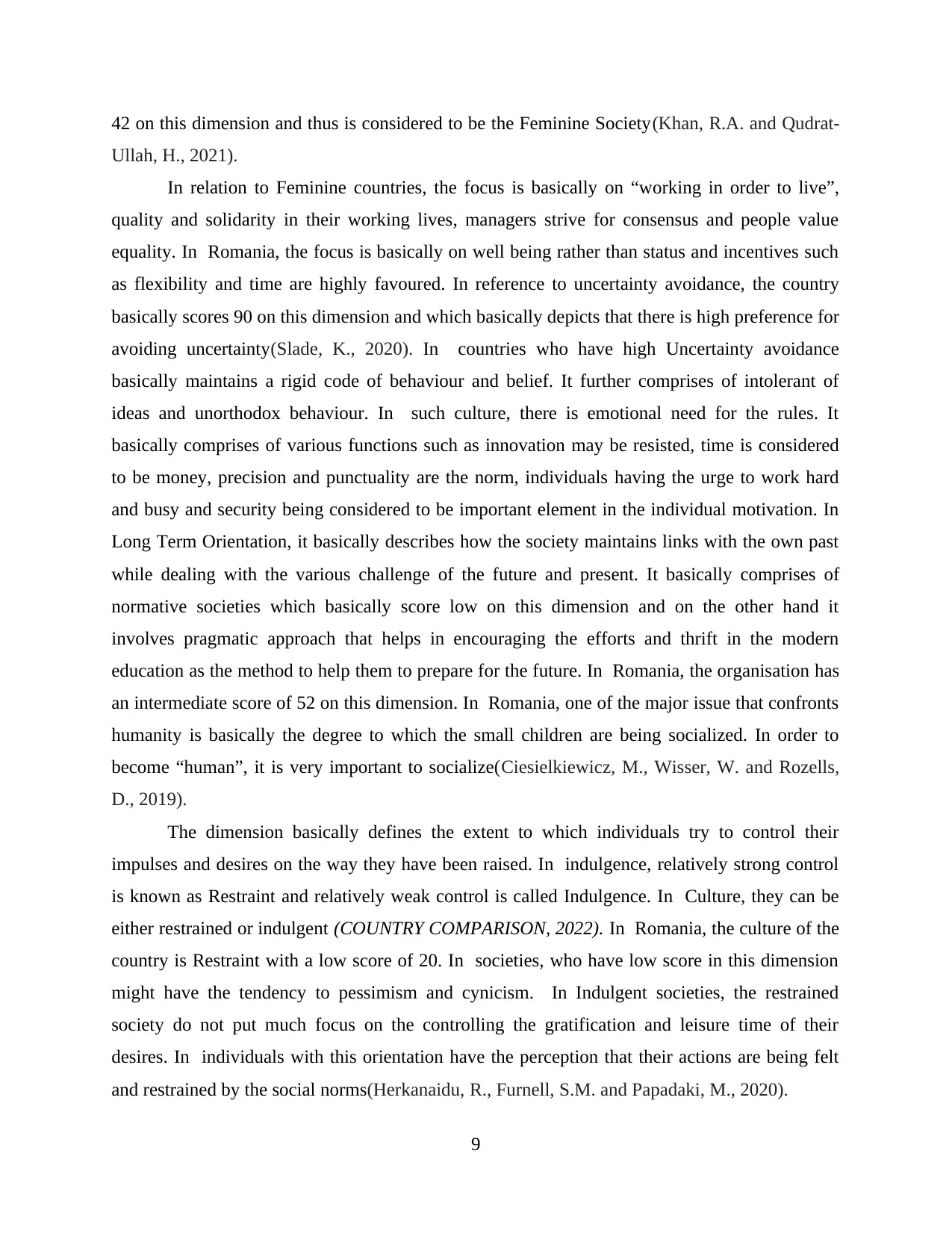
42 on this dimension and thus is considered to be the Feminine Society(Khan, R.A. and Qudrat-
Ullah, H., 2021).
In relation to Feminine countries, the focus is basically on “working in order to live”,
quality and solidarity in their working lives, managers strive for consensus and people value
equality. In Romania, the focus is basically on well being rather than status and incentives such
as flexibility and time are highly favoured. In reference to uncertainty avoidance, the country
basically scores 90 on this dimension and which basically depicts that there is high preference for
avoiding uncertainty(Slade, K., 2020). In countries who have high Uncertainty avoidance
basically maintains a rigid code of behaviour and belief. It further comprises of intolerant of
ideas and unorthodox behaviour. In such culture, there is emotional need for the rules. It
basically comprises of various functions such as innovation may be resisted, time is considered
to be money, precision and punctuality are the norm, individuals having the urge to work hard
and busy and security being considered to be important element in the individual motivation. In
Long Term Orientation, it basically describes how the society maintains links with the own past
while dealing with the various challenge of the future and present. It basically comprises of
normative societies which basically score low on this dimension and on the other hand it
involves pragmatic approach that helps in encouraging the efforts and thrift in the modern
education as the method to help them to prepare for the future. In Romania, the organisation has
an intermediate score of 52 on this dimension. In Romania, one of the major issue that confronts
humanity is basically the degree to which the small children are being socialized. In order to
become “human”, it is very important to socialize(Ciesielkiewicz, M., Wisser, W. and Rozells,
D., 2019).
The dimension basically defines the extent to which individuals try to control their
impulses and desires on the way they have been raised. In indulgence, relatively strong control
is known as Restraint and relatively weak control is called Indulgence. In Culture, they can be
either restrained or indulgent (COUNTRY COMPARISON, 2022). In Romania, the culture of the
country is Restraint with a low score of 20. In societies, who have low score in this dimension
might have the tendency to pessimism and cynicism. In Indulgent societies, the restrained
society do not put much focus on the controlling the gratification and leisure time of their
desires. In individuals with this orientation have the perception that their actions are being felt
and restrained by the social norms(Herkanaidu, R., Furnell, S.M. and Papadaki, M., 2020).
9
Ullah, H., 2021).
In relation to Feminine countries, the focus is basically on “working in order to live”,
quality and solidarity in their working lives, managers strive for consensus and people value
equality. In Romania, the focus is basically on well being rather than status and incentives such
as flexibility and time are highly favoured. In reference to uncertainty avoidance, the country
basically scores 90 on this dimension and which basically depicts that there is high preference for
avoiding uncertainty(Slade, K., 2020). In countries who have high Uncertainty avoidance
basically maintains a rigid code of behaviour and belief. It further comprises of intolerant of
ideas and unorthodox behaviour. In such culture, there is emotional need for the rules. It
basically comprises of various functions such as innovation may be resisted, time is considered
to be money, precision and punctuality are the norm, individuals having the urge to work hard
and busy and security being considered to be important element in the individual motivation. In
Long Term Orientation, it basically describes how the society maintains links with the own past
while dealing with the various challenge of the future and present. It basically comprises of
normative societies which basically score low on this dimension and on the other hand it
involves pragmatic approach that helps in encouraging the efforts and thrift in the modern
education as the method to help them to prepare for the future. In Romania, the organisation has
an intermediate score of 52 on this dimension. In Romania, one of the major issue that confronts
humanity is basically the degree to which the small children are being socialized. In order to
become “human”, it is very important to socialize(Ciesielkiewicz, M., Wisser, W. and Rozells,
D., 2019).
The dimension basically defines the extent to which individuals try to control their
impulses and desires on the way they have been raised. In indulgence, relatively strong control
is known as Restraint and relatively weak control is called Indulgence. In Culture, they can be
either restrained or indulgent (COUNTRY COMPARISON, 2022). In Romania, the culture of the
country is Restraint with a low score of 20. In societies, who have low score in this dimension
might have the tendency to pessimism and cynicism. In Indulgent societies, the restrained
society do not put much focus on the controlling the gratification and leisure time of their
desires. In individuals with this orientation have the perception that their actions are being felt
and restrained by the social norms(Herkanaidu, R., Furnell, S.M. and Papadaki, M., 2020).
9
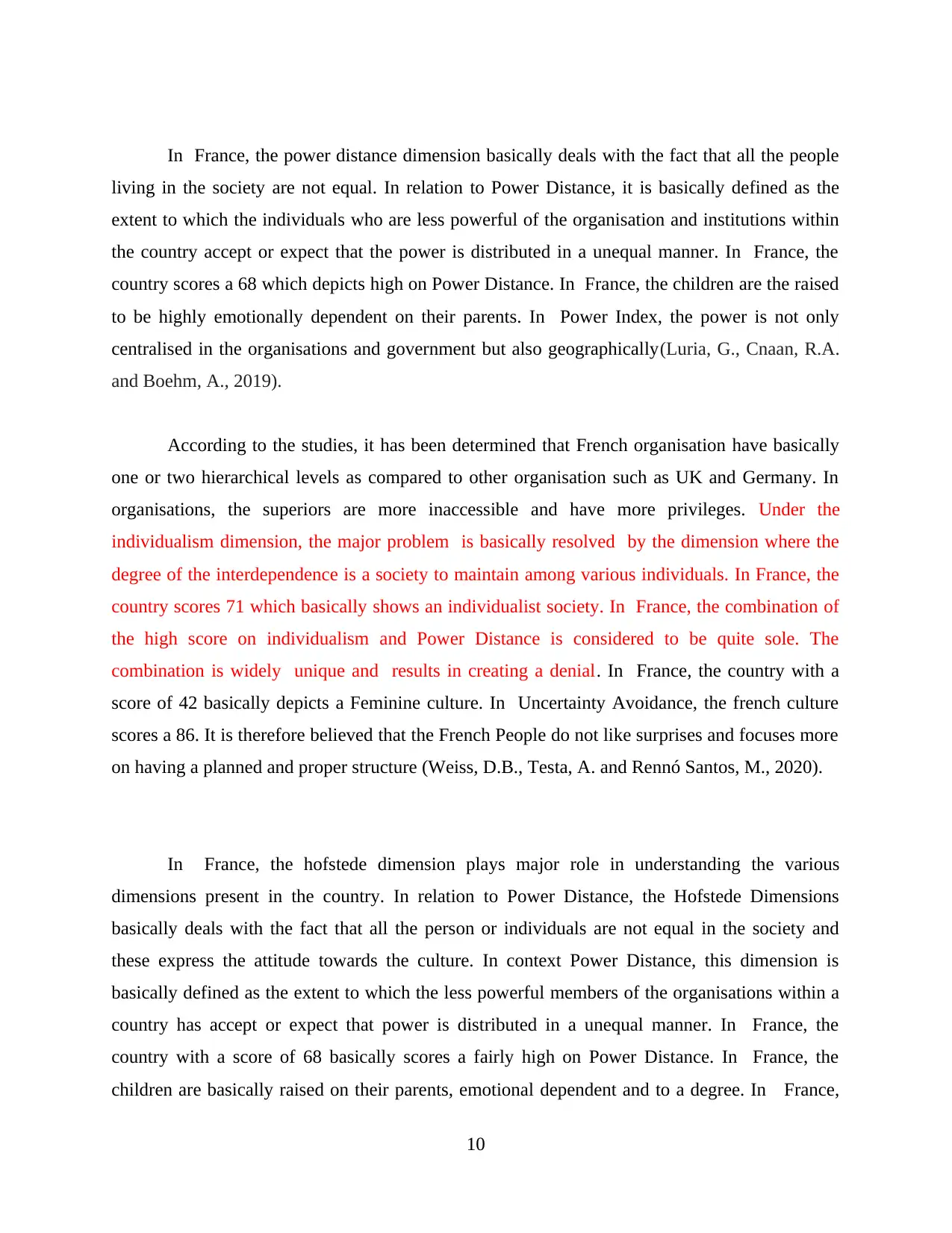
In France, the power distance dimension basically deals with the fact that all the people
living in the society are not equal. In relation to Power Distance, it is basically defined as the
extent to which the individuals who are less powerful of the organisation and institutions within
the country accept or expect that the power is distributed in a unequal manner. In France, the
country scores a 68 which depicts high on Power Distance. In France, the children are the raised
to be highly emotionally dependent on their parents. In Power Index, the power is not only
centralised in the organisations and government but also geographically(Luria, G., Cnaan, R.A.
and Boehm, A., 2019).
According to the studies, it has been determined that French organisation have basically
one or two hierarchical levels as compared to other organisation such as UK and Germany. In
organisations, the superiors are more inaccessible and have more privileges. Under the
individualism dimension, the major problem is basically resolved by the dimension where the
degree of the interdependence is a society to maintain among various individuals. In France, the
country scores 71 which basically shows an individualist society. In France, the combination of
the high score on individualism and Power Distance is considered to be quite sole. The
combination is widely unique and results in creating a denial. In France, the country with a
score of 42 basically depicts a Feminine culture. In Uncertainty Avoidance, the french culture
scores a 86. It is therefore believed that the French People do not like surprises and focuses more
on having a planned and proper structure (Weiss, D.B., Testa, A. and Rennó Santos, M., 2020).
In France, the hofstede dimension plays major role in understanding the various
dimensions present in the country. In relation to Power Distance, the Hofstede Dimensions
basically deals with the fact that all the person or individuals are not equal in the society and
these express the attitude towards the culture. In context Power Distance, this dimension is
basically defined as the extent to which the less powerful members of the organisations within a
country has accept or expect that power is distributed in a unequal manner. In France, the
country with a score of 68 basically scores a fairly high on Power Distance. In France, the
children are basically raised on their parents, emotional dependent and to a degree. In France,
10
living in the society are not equal. In relation to Power Distance, it is basically defined as the
extent to which the individuals who are less powerful of the organisation and institutions within
the country accept or expect that the power is distributed in a unequal manner. In France, the
country scores a 68 which depicts high on Power Distance. In France, the children are the raised
to be highly emotionally dependent on their parents. In Power Index, the power is not only
centralised in the organisations and government but also geographically(Luria, G., Cnaan, R.A.
and Boehm, A., 2019).
According to the studies, it has been determined that French organisation have basically
one or two hierarchical levels as compared to other organisation such as UK and Germany. In
organisations, the superiors are more inaccessible and have more privileges. Under the
individualism dimension, the major problem is basically resolved by the dimension where the
degree of the interdependence is a society to maintain among various individuals. In France, the
country scores 71 which basically shows an individualist society. In France, the combination of
the high score on individualism and Power Distance is considered to be quite sole. The
combination is widely unique and results in creating a denial. In France, the country with a
score of 42 basically depicts a Feminine culture. In Uncertainty Avoidance, the french culture
scores a 86. It is therefore believed that the French People do not like surprises and focuses more
on having a planned and proper structure (Weiss, D.B., Testa, A. and Rennó Santos, M., 2020).
In France, the hofstede dimension plays major role in understanding the various
dimensions present in the country. In relation to Power Distance, the Hofstede Dimensions
basically deals with the fact that all the person or individuals are not equal in the society and
these express the attitude towards the culture. In context Power Distance, this dimension is
basically defined as the extent to which the less powerful members of the organisations within a
country has accept or expect that power is distributed in a unequal manner. In France, the
country with a score of 68 basically scores a fairly high on Power Distance. In France, the
children are basically raised on their parents, emotional dependent and to a degree. In France,
10
⊘ This is a preview!⊘
Do you want full access?
Subscribe today to unlock all pages.

Trusted by 1+ million students worldwide
1 out of 19
Related Documents
Your All-in-One AI-Powered Toolkit for Academic Success.
+13062052269
info@desklib.com
Available 24*7 on WhatsApp / Email
![[object Object]](/_next/static/media/star-bottom.7253800d.svg)
Unlock your academic potential
Copyright © 2020–2025 A2Z Services. All Rights Reserved. Developed and managed by ZUCOL.




